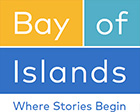This article was originally published in nzherald.co.nz, 9th November 2016 by By Alex Braae.who travelled to the Bay of Islands with assistance from Bay of Islands Marketing Group.

Imagine hosting an overseas visitor in New Zealand in February. They turn on television news to images of protests, of political leaders being jostled.
What’s Waitangi all about, they ask? Where to begin?
As New Zealanders, we are awkward enough about our own history, let alone explaining the complexity of it to foreigners. With overseas tourists flooding into Paihia and the incomparably beautiful Bay of Islands, the Waitangi Treaty Grounds may well be the perfect place to start that conversation. There’s no doubt they’re up to the challenge.
The Waitangi Treaty Grounds owns and confronts the history of Aotearoa, telling our stories in complex, empathetic ways. It’s changed dramatically in the past decade. A museum has been opened along with gallery space and a visitor centre. Cultural performances take place for tour groups.
As we approached the water, our guide John pointed across the bay to Kororareka, otherwise known as Russell (and by some at the time, the hellhole of the South Pacific) and told a little known story of Hone Heke, whom most know as the man who chopped down a British flagpole.
As John explained, Heke was actually the chief who convinced other iwi to sign Te Tiriti, and was told by Governor Hobson in words that now carry heavy political baggage, “he iwi tahi tatou” — we are now one people. Those words were ringing in his ears a few years later when he took an axe to the solitary flagpole at Kororareka. If Maori and British were equal partners in becoming one people, why did only the Union Jack fly, and not the United Tribes flag too?

That willingness to confront difficult historical truths comes through strongest in the museum and gallery. Accounts of raids, revenge killings and dispossession are presented with a commitment to accuracy and honesty, rather than condemnation. It’s not all doom and gloom: New Zealand’s better moments of racial co-operation and trade are also highlighted.
Our tour group were greeted with a traditional wero. Our representative for the day (Chief Darryl of the self-described Tourist Tribe) looked a tad nervous as he reached down to pick up the branch. Having grown up in New Zealand it can be easy to forget that a powhiri isn’t universally understood as a welcoming ceremony, and our fearless chief may have wondered if he was about to cop a taiaha.
Then we entered the whare, where a performance group expertly weaved traditional waiata and haka with modern additions. I was stoked to see a guitar busted out alongside the purerehua — a cord instrument swung in circles, that makes a deep humming sound. It was real. The Waitangi performance group were accomplished at drawing on their own experiences in bringing their music to life. The plug at the end for Trip Advisor reviews was handled deftly too.
Questions will inevitably be asked about whether Waitangi should have been turned into a tourist attraction. As a site of such significance, perhaps it would have been better to leave it as an undisturbed, sacred place. For those who feel that way, it can still be. Even on a sunny spring Saturday there was plenty of time and space to simply sit on the edge of the water and contemplate the Treaty House, the wharewaka, and the tui that flit between the trees.
The Waitangi Treaty Grounds can now be a space for education, communication and commemoration. It’s unparalleled in New Zealand. It is a taonga that can be shared with the world.
While you’re in the area
Mingle with the crowds on market nights. Every Friday night Paihia has an open air party, with local and travelling musicians to warm the nights. Food stalls abound on the waterfront, and there’s plenty of freshly caught fish.
Sail around the islands that speckle the harbour. The voyages of the Fullers Great Sights Ferry include passing through the famous Hole in the Rock. Lucky passengers might catch a glimpse of seals or dolphins. It’s the perfect way to get across the bay to Russell, which is worth the trip alone.
Eat a huge range of food. From the high concept cuisine of Charlotte’s Kitchen, to the excellent fish and chips at Vinnie’s, Paihia will satisfy all tastes. Take your feast to the beach.
 Drive into the hills around Paihia for glimpses of the past. Te Waimate Mission is the second-oldest building in New Zealand, preserving the architecture of an era that shaped our history. Look for signs tucked around corners of roads that point to landmarks in the life of James Busby, an early pioneer among Pakeha, who became close with local iwi.
Drive into the hills around Paihia for glimpses of the past. Te Waimate Mission is the second-oldest building in New Zealand, preserving the architecture of an era that shaped our history. Look for signs tucked around corners of roads that point to landmarks in the life of James Busby, an early pioneer among Pakeha, who became close with local iwi.
Kayak into the gently lapping waves. For those who want to work for their moments of tranquility, the Bay of Islands has perfect conditions for paddling. Hire kayaks to travel to hidden gems and sheltered nooks, and fine sandy beaches to lounge on, or take a tour to be shown around the best spots.
If you go
Stay at: Scenic Hotel, Paihia.
